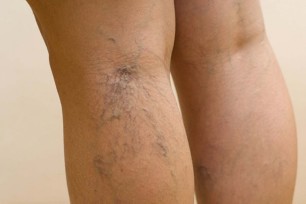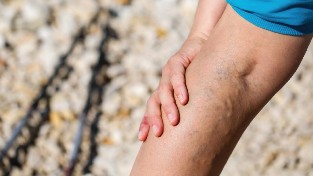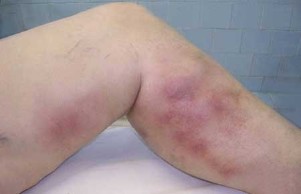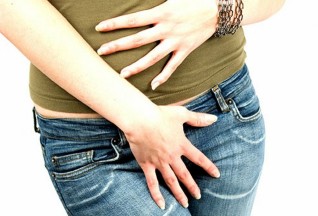
Pain in the legs and swelling, burning and swollen veins - such signs of varicose veins are familiar to almost every third woman. But few of the ladies know that such alarm bells signal the onset of a complex disease that requires a special approach to treatment. At later stages, the situation is aggravated and dangerous complications such as blood clots, trophic ulcers and bleeding are added to the standard signs. In addition, it is not uncommon for the problem to spread from the legs to other parts of the body.
Varicose veins is an insidious disease that is not indifferent to the fair sex. Features of hormonal levels, love for uncomfortable footwear, weight gain due to pregnancy and other hormonal changes leave indelible marks on vascular health. Therefore, it is so important to recognize the signs of varicose veins of the legs in women in time, which will allow to take adequate measures in a timely manner and prevent dangerous consequences.
Where does varicose veins begin?
After spending the whole day on their feet, women do not attach importance to fatigue, swelling and even pain. Such a reaction seems quite natural after a long walk in heels or just a hard day at work. And prolonged physical activity, intensified, incorrectly selected training programs for the legs do not have the best effect on the condition of female legs. And even fat young ladies do not pay attention to the increased volume of the legs and bluish convolutions that appear through the skin.
But it is precisely these signs of varicose veins of the legs in women that are the first alarm bells.

When should you start to be anxious? Does the slightest trouble associated with an unnatural condition of the legs indicate a serious illness?
This is precisely the insidiousness of venous problems. At the initial stage, it is almost impossible to distinguish the symptoms of varicose veins of the legs in women from other diseases or overwork.
But even if there is no genetic or physiological predisposition to varicose veins, you should consult a doctor if you find:
Increased leg fatigue. Habitual stress causes rapid fatigue, while performance is significantly reduced. Even after daily work, there is a desire to rest the legs. The standing position causes discomfort.
Burning sensation, pain or discomfort in the legs, especially in the evenings and at night. The pain can be migratory in nature or affect different parts of the legs, from the soles to the groin. In this case, there is a desire to massage painful areas. Sometimes the pain is so severe that you have to take analgesics.
Heaviness in the legs. It occurs in women often after a long stay in heels or in uncomfortable shoes. But even when the shoes are removed, the feeling of heaviness does not disappear. For relief, the legs are given a horizontal or raised position.
Only at first glance, varicose veins are difficult to recognize in women by such symptoms. In practice, it is worth listening to your feelings, and it will become clear that unnatural processes are taking place in your legs. And in order to finally dispel your doubts, it is better to consult a doctor.
It is much easier to detect visual symptoms with initial varicose veins in women. It can be:
venous asterisks;
bruising suddenly or for no reason;
vascular convolutions protruding through the thin skin.
And most importantly, such symptoms of varicose veins on the legs in women can be determined much easier than in men. This is due to the fact that young ladies have thinner skin. And in addition to the physiological characteristics, almost all the fair sex get rid of any vegetation on their legs. This facilitates the detection of even a fine vascular network, not to mention the nodes and distended veins.
Important! With the initial symptoms of varicose veins in women, treatment is not difficult. Therefore, do not miss the opportunity to get rid of a dangerous disease at the start.
How does the second stage manifest?
If treatment is not started, the signs of blood stagnation worsen. In addition, the structure of the venous walls is disturbed, vasodilation occurs. At the same time, the valves begin to close.

Signs of varicose veins in women in the second stage are manifested:
pronounced constant heaviness and a feeling of fullness in the legs, especially in the lower part;
enlarged veins, often in the popliteal fossa;
the appearance of causeless fatigue and pain;
cramps in the calf muscles, troubling at night;
feeling of creeping creeps.
Discomfort and fatigue do not disappear even after changing the position of the legs and adopting a horizontal position. Venous outflow at this stage begins to be disrupted, which becomes a natural reason for the formation of nodules.
But even with such symptoms of varicose veins in women, treatment can be selected. Moreover, behavioral therapy at this stage is no less important than drug and physiotherapy treatment.
Progressive stage of varicose veins
At the subcompensatory third stage, all signs of the disease become apparent. They can no longer be confused with the symptoms of other pathologies. This is due to the development of chronic congestion and impaired blood flow.

Against the background of such changes:
The pain becomes chronic. It becomes burning, exhausting. A woman simply does not know what to do with such pain, and at night, where to find a place for her legs. This leads to sleep problems and nervous disorders.
Puffiness is not observed only in the morning. But by lunchtime, my legs begin to swell. But since a woman at this time is most often at work, she does not have the opportunity to take off her shoes and give her legs a rest. By the end of the day, the swelling increases even more.
Itching, constant creeping, severe cramps join the unpleasant sensations.
Toenails begin to break, crumble and hair falls out.
The external signs of varicose veins on the legs of women are now becoming significant. These include the appearance of:
visible varicose nodules;
saccular veins;
translucency through the skin of elongated veins with a characteristic tortuosity in the thighs, the inner surface of the legs, which are easily palpable;
brown spots, unnatural pigmentation, as well as seals in the lower leg;
dermatitis against the background of thinning of the skin.
With such signs of varicose veins of the legs in women, it is already difficult to choose a treatment. It will be long-term and not always successful.
Stage four with complications
The last stage is characterized by the appearance of complications against the background of an increase in all characteristic signs. This is due to the development of severe venous insufficiency and malnutrition of all tissues. The danger is that almost all complications pose a threat to the patient's life.
Formation of trophic ulcers
Trophic changes in the skin occur due to impaired blood flow. At the site of the appearance of ulcers, the patient first feels itching, burning.

The color of the skin changes, after which obvious wounds appear. They have jagged edges and a rounded shape. The sore is purple or purple in color. Over time, a scab appears at the site of the wound. The contents of a purulent, serous, hemorrhagic nature with streaks of fibrin can be released from the ulcer.
Further developments will depend on the treatment strategy. With a properly selected therapy regimen, a scar appears at the site of the ulcer. If you do not carry out treatment, there is a high probability of infection. In this case, gangrene is not excluded, in which antibacterial treatment is powerless. It is often about limb amputation. Even more dangerous is sepsis, leading to the death of the patient.
Traumatic bleeding
Against the background of thinning of the venous wall, even a minor injury can cause its rupture. Such damage results in massive bleeding, which requires urgent surgical intervention.
Thrombophlebitis
Blood clots form in the veins due to stagnant and inflammatory processes.

With such a complication, the patient observes specific symptoms in the form of:
hypersensitivity of the skin;
pronounced pain syndrome of a local nature in the projection of the thrombosis site;
hyperemia of the skin with an increase in skin temperature;
soreness and tightness of the vein on palpation.
With such a dangerous symptomatology, urgent hospitalization is indicated. The consequences of blood clots can be dire. The resulting blood clot can come off at any time. It is rather difficult to predict how he will behave further. Often, this problem ends with a heart attack, stroke or blockage of the pulmonary artery with a fatal outcome.
Signs of other types of varicose veins in women
The vascular system of any woman is constantly exposed to negative external influences and internal shocks associated with a genetic predisposition and the presence of certain concomitant diseases. All this is aggravated by hormonal storms occurring against the background of adolescence, pregnancy, feeding, menopause. Almost all women are at risk, and every third becomes a patient of a phlebologist. Expansion of veins for women is not such a rare phenomenon. And the most dangerous thing is that it covers not only the legs, but other parts of the body.
Upper limbs
With the defeat of the upper extremities, the symptoms are similar to those of varicose veins of the legs.

But patients begin to sound the alarm only with increased swelling and pain. Many people suffer from night cramps, twitching and numbness of the fingers.
Over time, doing housework and basic self-care becomes more difficult. The appearance of complications with deep vein thrombosis is also possible.
In the small pelvis
Varicose changes in the small pelvis are often confused with inflammatory diseases of the internal organs or problems with the musculoskeletal system.
After all, women complain of aching pains in the lower abdomen, radiating to the sacral and lumbar regions.
Sometimes there are problems with urination, pressure on the rectum. The duration of the menstrual cycle changes, and the discharge itself becomes scarce. The uterus becomes especially sensitive, which provokes problems with proximity.
In the groin
With varicose veins in the groin in women, symptoms of a visual nature such as a venous pattern, spider veins, nodes are found in the upper thighs, labia, groin, buttocks.

The pain extends not only to the affected area, but also to the genitals, lower back, and perineum.
During intercourse, a woman experiences some discomfort. Urination is also impaired, causing a burning sensation. The skin in the affected area becomes dry, thinned. Sometimes unbearable itching occurs.
Hemorrhoidal veins
The defeat of the hemorrhoidal veins leads to the development of hemorrhoids. Moreover, the clinical picture of the internal form at the first stage is hardly noticeable. In the future, the symptoms will depend on the stage of the disease. This form of varicose veins is especially painful at any stage of development. Lumps fall out of the intestine, injured, bleed.
It is almost impossible to cope with hemorrhoids without medical assistance. And even the right treatment does not always give the expected results. The only correct way out in such situations is surgery. And now such operations have become affordable financially and less traumatic.
As you can see, varicose veins is a multifaceted pathology. And the clinical picture can cover both characteristic signs and specific ones. And the consequences of the disease are completely deplorable. Therefore, it will not hurt for every woman to know not only the signs of varicose veins, but also prevention methods in the form of exercise on a stationary bike, gymnastics for tired legs. Indeed, for any disease, the best treatment is its prevention.












































